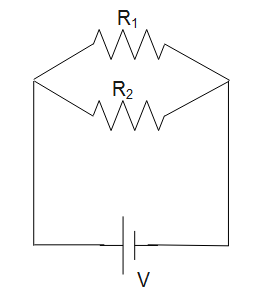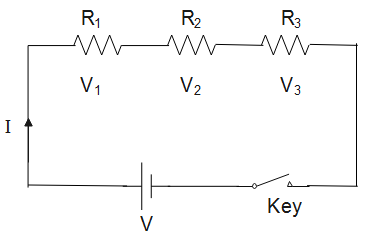
Two unequal resistances are connected in parallel. Which of the following statements is true?
A). Current is same in both
B). Current is larger in higher resistance
C). Voltage drop is the same in both
D). Voltage drop is lower in lower resistance.
Answer
544.5k+ views
Hint: In this question we will learn the basics of a parallel connection in a basic circuit. This will help us to get the required answer. Further, we will discuss the basics of a series connection and also about Ohm’s law, for our better understanding
Complete step by step solution:
As we know that, in parallel connection, all the elements like resistance and current, are connected between the same two points.
As we can see in the below diagram, two unequal resistors are connected between two points.

In parallel connection, the total resistance is given as:
$\dfrac{1}{{{R_T}}} = \dfrac{1}{{{R_1}}} + \dfrac{1}{{{R_2}}}$
So, the voltage drop across any number of resistors or any other elements which are connected in parallel is the same.
Therefore, from the above observation, the correct option is C) i.e., voltage drop is the same in both the resistors.
Additional information: We should know that in a series circuit, the output current of the first resistor flows into the input of the second resistor; so, the current is the same in each resistor whereas In a parallel circuit, all of the resistor are on connected together on one side and all the leads on the other side are connected together.
In the given circuit diagram, a series connection is shown having three resistors and the respective voltages and the current flowing through the circuit.

In a circuit if the resistance is constant over a range of voltage, then I = V/R, can be used to predict the behavior of the material. This involves DC current and voltage, it is the same for the resistors. Further, a material obeys Ohm's law or does not obey; the resistance of the material can be described in terms of its bulk. The resistivity, and the resistance both, is temperature dependent. Over certain ranges of temperature, this temperature dependence can be predicted from resistance.
Note: There are limitations to the Ohm’s law. They are valid only for conductors not for all materials. We should also note that resistance is inversely proportional to the flow of current. The unit of resistance is ohm, named after the scientist.
Complete step by step solution:
As we know that, in parallel connection, all the elements like resistance and current, are connected between the same two points.
As we can see in the below diagram, two unequal resistors are connected between two points.

In parallel connection, the total resistance is given as:
$\dfrac{1}{{{R_T}}} = \dfrac{1}{{{R_1}}} + \dfrac{1}{{{R_2}}}$
So, the voltage drop across any number of resistors or any other elements which are connected in parallel is the same.
Therefore, from the above observation, the correct option is C) i.e., voltage drop is the same in both the resistors.
Additional information: We should know that in a series circuit, the output current of the first resistor flows into the input of the second resistor; so, the current is the same in each resistor whereas In a parallel circuit, all of the resistor are on connected together on one side and all the leads on the other side are connected together.
In the given circuit diagram, a series connection is shown having three resistors and the respective voltages and the current flowing through the circuit.

In a circuit if the resistance is constant over a range of voltage, then I = V/R, can be used to predict the behavior of the material. This involves DC current and voltage, it is the same for the resistors. Further, a material obeys Ohm's law or does not obey; the resistance of the material can be described in terms of its bulk. The resistivity, and the resistance both, is temperature dependent. Over certain ranges of temperature, this temperature dependence can be predicted from resistance.
Note: There are limitations to the Ohm’s law. They are valid only for conductors not for all materials. We should also note that resistance is inversely proportional to the flow of current. The unit of resistance is ohm, named after the scientist.
Recently Updated Pages
Master Class 12 English: Engaging Questions & Answers for Success

Master Class 12 Business Studies: Engaging Questions & Answers for Success

Master Class 12 Economics: Engaging Questions & Answers for Success

Master Class 12 Social Science: Engaging Questions & Answers for Success

Master Class 12 Maths: Engaging Questions & Answers for Success

Master Class 12 Chemistry: Engaging Questions & Answers for Success

Trending doubts
What are the major means of transport Explain each class 12 social science CBSE

Which are the Top 10 Largest Countries of the World?

Draw a labelled sketch of the human eye class 12 physics CBSE

Explain sex determination in humans with line diag class 12 biology CBSE

Explain sex determination in humans with the help of class 12 biology CBSE

Differentiate between homogeneous and heterogeneous class 12 chemistry CBSE




